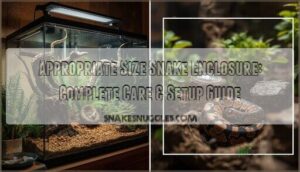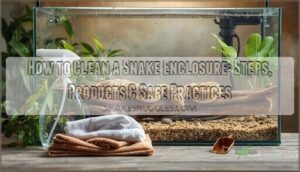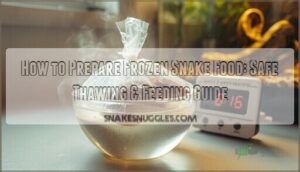This site is supported by our readers. We may earn a commission, at no cost to you, if you purchase through links.

It’s about understanding how every element of captive care—from substrate chemistry to thermal gradients—directly impacts your snake’s physiology. Small mistakes in husbandry protocols compound over time, leading to metabolic disorders, infections, and premature death.
Whether you’re setting up your first enclosure or refining your approach with an established collection, evidence-based husbandry practices form the foundation of responsible snake keeping and long-term animal welfare.
Table Of Contents
- Key Takeaways
- Setting Up The Ideal Snake Enclosure
- Feeding and Nutrition for Pet Snakes
- Maintaining Snake Health and Hygiene
- Safe Handling and Snake Behavior Tips
- Choosing The Right Snake and Conservation
- Frequently Asked Questions (FAQs)
- Do veterinary personnel work with snakes?
- What should veterinary staff do if a pet snake is a problem?
- How do you handle a snake?
- How do you care for a snake?
- How do you bring a pet snake to a veterinary clinic?
- How do I choose a beginner snake?
- What is husbandry for snakes?
- What are the requirements for reptile husbandry?
- How often should snakes’ water be changed?
- What is the best way to care for a snake?
- Conclusion
Key Takeaways
- Proper enclosure setup—including safe substrates, precise temperature gradients (85-95°F basking, 75-80°F cool zone), species-specific humidity levels, and multiple hides—directly prevents respiratory infections, metabolic disorders, and chronic stress that cause most captive snake deaths.
- Frozen-thawed whole prey fed on age-appropriate schedules (hatchlings every 5-7 days, adults every 7-14 days) eliminates injury risk from live rodents while providing complete nutrition that prevents deficiencies leading to metabolic bone disease and organ failure.
- Proactive health monitoring through daily waste removal, monthly deep cleaning with reptile-safe disinfectants, 60-90 day quarantine for new animals, and annual veterinary exams catches subclinical infections early, since respiratory issues affect 21% of visits and internal parasites appear in 39% of tested snakes.
- Strategic handling that starts with brief 5-minute sessions twice weekly, progresses gradually based on stress signals (tongue flicking, S-coiling, hissing), and always supports the snake’s full body weight builds trust without triggering defensive responses or chronic stress that compromises long-term health.
Setting Up The Ideal Snake Enclosure
Your snake’s enclosure isn’t just a container—it’s the foundation of their health and behavior. Getting the setup right from the start means fewer stress-related health issues and a more confident, thriving animal.
Let’s walk through the five essential elements that make an enclosure work for your snake.
Choosing The Right Enclosure Size and Type
Your snake’s enclosure isn’t just a container—it’s the foundation of every aspect of its health, from thermoregulation to stress levels.
You’ll need an enclosure at least as long as your snake with secure, escape-proof lids that prevent snake escapes while maintaining proper ventilation systems.
Glass or Plexiglas materials offer excellent visibility and humidity control, making reptile enclosure setup straightforward and tank security reliable for your snake enclosure requirements.
Selecting Safe Substrate Options
The substrate beneath your snake determines far more than just the look of its home—it directly impacts respiratory health, thermoregulation efficiency, and injury risk. You’ll want to avoid loose substrates that pose impaction risks if ingested during feeding.
Paper towels, reptile carpet, and newspaper offer excellent cleaning ease while eliminating substrate toxicity concerns.
For naturalistic options with better humidity retention, cypress mulch works well for tropical species, though you’ll need to monitor enclosure requirements for reptiles more closely. Choose substrates that support your specific snake’s needs without compromising safety.
Temperature, Lighting, and Heat Sources
Once you’ve nailed down the substrate, your next priority is creating the precise thermal gradient that lets your snake regulate its body temperature—because, unlike you, it can’t generate its own heat. You’ll need to establish distinct zones using heat sources like under-tank heat mats or overhead heat lamps:
- Basking zone: 85–95°F depending on species
- Cool zone: 75–80°F for retreat
- Ambient temperature: Mid-range throughout enclosure
Most snakes don’t require UVB lighting, though heat lamps can simulate natural photoperiods. Always use thermostats to prevent dangerous overheating.
Managing Humidity Levels
After dialing in your thermal gradient, humidity becomes your next calibration point—get it wrong, and you’ll see poor sheds, respiratory issues, or chronic dehydration in your snake. Species-specific requirements vary dramatically: ball pythons need 50–60% humidity, while rainbow boas demand 75–90%.
Monitor levels using a calibrated hygrometer, adjusting through water bowls, ventilation systems, or humidity boxes with dampened substrate for moisture management.
Creating Hides, Climbing Areas, and Decor
Your snake won’t thrive in a barren box—strategically placed hides, climbing structures, and enrichment features transform sterile housing into functional habitat that fosters natural behaviors and reduces stress.
Consider these essential cage furniture elements:
- Hide boxes on both thermal zones (warm and cool sides)
- Visual barriers like decorative rock or cork bark for security
- Climbing structures (branches, ledges) for arboreal species
Proper snake enclosure setup with hiding spots and environmental enrichment directly reduces stress-related health issues in your reptile enclosure.
Feeding and Nutrition for Pet Snakes
Snakes are obligate carnivores, which means their nutritional needs depend entirely on whole prey items. Getting the feeding schedule, prey type, and hydration right isn’t just important—it’s essential for your snake’s long-term health.
Let’s break down the key aspects of snake nutrition you need to master.
Whole Prey Diets and Feeding Frequency
As obligate carnivores, snakes require whole prey items that provide complete nutritional profiles—bones, organs, fur, and all—mimicking what they’d consume in their natural habitat. Understanding carnivorous diet basics and reptile nutrition principles helps you maintain ideal feeding requirements for your snake’s long-term health.
Your feeding schedules should align with your snake’s age and digestion rates. Proper prey item selection guarantees your snake meets its nutrient requirements without digestive complications.
| Life Stage | Meal Frequency |
|---|---|
| Hatchlings | Every 5-7 days |
| Juveniles | Every 5-7 days |
| Adults | Every 7-10 days |
| Large Adults | Every 10-14 days |
Hatchlings need smaller prey items every 5-7 days, while adults thrive on appropriately sized rodents every 7-10 days.
Benefits of Frozen-Thawed Vs. Live Prey
Frozen-thawed prey eliminates the most significant risk in captive snake feeding—defensive rodent bites that can cause severe injuries or fatal infections to your snake. This feeding safety approach supports ideal snake digestion and overall snake health without the stress live prey introduces to your snake’s environment.
You’ll also find frozen-thawed rodents offer consistent prey nutrition and excellent rodent quality, while proper food storage maintains reptile nutrition standards.
Water Requirements and Hydration Tips
While prey selection often dominates feeding discussions, adequate hydration remains equally critical to proper snake physiology and successful ecdysis cycles. You’ll need to maintain water quality standards through consistent bowl placement and monitor dehydration signs carefully.
Essential hydration methods for snake care:
- Provide a water bowl large enough for complete soaking
- Change water daily to prevent bacterial contamination
- Position bowls on the cooler side to minimize evaporation
- Maintain species-specific humidity control between 40-70%
- Monitor for sunken eyes or wrinkled skin indicating dehydration
Avoiding Nutritional Deficiencies
Nutritional deficiencies don’t announce themselves until damage is done—metabolic bone disease, neurological dysfunction, and organ failure can stem from seemingly minor dietary gaps. Mixed whole-prey diets deliver ideal vitamin balance and mineral supplements naturally, with calcium intake ratios near 1.7:1 supporting skeletal health.
Dietary variety prevents thiamine deficiency in fish-fed species and maintains nutrient cycling through trace minerals like iron and copper. Rotate frozen prey every three months to preserve fat-soluble vitamins, securing your snake’s diet mirrors the nutritional complexity wild populations enjoy.
Understanding reptile bone health is vital for preventing metabolic bone disease in snakes and other reptiles.
Maintaining Snake Health and Hygiene
Keeping your snake healthy goes beyond feeding—it requires proactive hygiene, vigilant disease monitoring, and consistent enclosure maintenance. You’ll need to recognize early warning signs of illness, establish proper cleaning protocols, and know when professional veterinary care is essential.
Let’s examine the core practices that prevent health problems and keep your snake thriving.
Common Health Issues and Disease Prevention
Respiratory infections bring snakes to veterinarians more than any other problem—up to 21% of visits stem from improper husbandry. Watch for wheezing, open-mouth breathing, and visible mucus in your snake’s respiratory tract.
Internal parasites affect 39% of tested pet snakes during annual exams, while external mites can trigger severe anemia in heavy infestations.
Disease diagnosis requires veterinary guidance and routine screening to catch subclinical infections early, protecting your snake’s health and wellbeing. Regular checks for snake health issues can help prevent common problems.
Cleaning and Disinfecting Enclosures
Keeping the enclosure clean protects your snake from bacterial overgrowth and mold that thrive in warm, humid environments. Your cleaning schedule directly impacts snake care outcomes and husbandry success.
Follow these hygiene protocols for effective enclosure sanitation:
- Daily waste removal—spot-clean feces and urates immediately to prevent pathogen proliferation
- Weekly substrate replacement—remove and replace non-reusable bedding in high-traffic areas
- Monthly deep cleaning—use reptile-safe disinfectant types like diluted bleach (1:30 ratio) or commercial quaternary ammonium solutions, guaranteeing thorough rinsing
Quarantine and Isolation Procedures
Before you introduce a new snake to your collection, you’ll need to set up a quarantine protocol that prevents disease transmission between animals. Maintain isolation techniques for 60–90 days in a separate room with dedicated equipment.
During quarantine periods, conduct disease screening through fecal exams and physical assessments. Implement strict biosecurity protocols—wash hands thoroughly and change clothing between management sessions.
Document all observations using quarantine and recordkeeping for reptiles to track snake health issues effectively.
Regular Veterinary Check-Ups
Once quarantine wraps up and your snake has a clean bill of health, you’ll want to schedule annual veterinary visits to catch potential problems before they become serious.
A qualified reptile veterinarian can use diagnostic tools like fecal exams and physical assessments to detect snake health issues early. These preventive measures guarantee your snake’s long-term wellbeing and address concerns you might miss during routine care.
Safe Handling and Snake Behavior Tips
Understanding how your snake communicates and reacts to being touched is essential for keeping both of you safe and stress-free. Proper technique reduces the risk of injury while building trust between you and your pet.
The following guidelines will help you recognize behavioral cues, establish secure touch practices, and create positive interactions.
Proper Handling Techniques and Safety
Managing a snake isn’t like picking up a puppy—these animals rely on predictable, deliberate movements to feel secure and avoid triggering a defensive response. Support your pet snake’s body weight evenly using both hands, applying gentle restraint without squeezing.
Snake hooks help with initial positioning, while handling gloves offer safety precautions during acclimation. Always secure enclosure lids for escape prevention, and wash hands before and after each session to maintain proper snake care.
Recognizing Stress and Behavioral Cues
Your snake’s body language tells you everything you need to know about its comfort level—learning to read these signals separates confident caregivers from those who misinterpret natural behaviors as aggression.
Watch for these stress signals:
- Rapid tongue flicking indicates heightened alertness or anxiety
- S-shaped coiling suggests defensive posturing
- Hissing or striking motions warn you’re pushing boundaries
- Reduced appetite signals environmental stressors affecting snake health and wellness
- Excessive hiding reveals inadequate environmental enrichment
Recognizing behavioral changes helps you adjust snake care practices and respect your pet’s temperament.
Handling Frequency and Acclimation
Most keepers rush the bonding process, but strategic management intervals matched to your snake’s stress tolerance will transform a defensive juvenile into a calm adult far faster than daily forced interaction. Start with 5-minute sessions twice weekly, gradually increasing duration as your snake demonstrates relaxed behavior—this acclimation technique respects natural stress thresholds while building trust through gentle touch and consistent taming practices.
Frequency limits matter—over-management triggers chronic stress and compromises snake behavior and communication patterns that caring for pet snakes requires you to recognize.
| Life Stage | Initial Frequency | Session Duration | Acclimation Period | Behavioral Goal |
|---|---|---|---|---|
| Hatchling (0-6 months) | 1-2x weekly | 3-5 minutes | 4-6 weeks | Reduced defensiveness |
| Juvenile (6-18 months) | 2-3x weekly | 5-10 minutes | 6-8 weeks | Calm exploration |
| Subadult (18-36 months) | 3-4x weekly | 10-15 minutes | 8-12 weeks | Confident management |
| Adult (3+ years) | 3-5x weekly | 15-20 minutes | Ongoing | Consistent temperament |
| Post-feeding | Skip 48-72 hours | N/A | Always observe | Prevent regurgitation |
Supervising Children and Other Pets
When children reach for a snake with sticky fingers or a curious dog lunges at the enclosure glass, you’re witnessing why mixed-species households demand vigilant supervision protocols that most first-time keepers dangerously underestimate. Proper pet safety tips and family awareness transform household risks into manageable interactions that protect both your pet snake and vulnerable family members.
Essential Supervision Protocols:
- Child education first—teach appropriate reptile care boundaries before any contact, emphasizing gentle observation over grabbing
- Snake-proofing your space—secure enclosure locks prevent escapes and unauthorized access by curious toddlers or pets
- Separate interaction zones—never allow dogs, cats, or other animals near your snake during manipulation sessions
- Constant adult presence—supervise every child-snake interaction regardless of experience level to guarantee animal welfare
- Recognize snake behavior cues—educate family members on stress signals that indicate your snake needs immediate isolation
Choosing The Right Snake and Conservation
Choosing the right snake isn’t just about picking one that looks cool—it’s about matching a species to your experience level and committing to responsible ownership.
Your decisions also ripple outward, affecting wild populations and ecosystems. Here’s what you need to think about before bringing a snake home.
Researching Species and Temperament
Choosing a pet snake without understanding species-specific temperament is like buying a car without checking if it’s manual or automatic—you need to know what you’re working with. Ball pythons, for instance, show defensive bites in only 0.7% of surveyed collections, making them ideal for beginners. Corn snakes start shy but grow tolerant with consistent, gentle interaction.
Research reveals that 95% of beginner owners prioritize docility, yet nearly half misidentify stress behaviors. Owners who study snake behavior before acquisition report 25% fewer stress-related issues. Understanding temperament testing methods and species research guarantees proper pet suitability and thorough owner preparation.
Sourcing From Reputable Breeders
A breeder’s reputation can make the difference between bringing home a healthy, well-adjusted snake and inheriting someone else’s husbandry mistakes—plus medical bills you didn’t budget for.
Verify breeding ethics through references, facility visits, and health guarantees. Ask for snake pedigree records and pet certification documentation.
Reputable breeders discuss reptile laws, species-specific care for ball pythons and other snake species, and provide ongoing reptile care support.
Avoiding Wild-Caught and Invasive Species
Wild-caught snakes carry parasites, stress-related illnesses, and ecological consequences that captive-bred specimens simply don’t—and choosing the wrong origin can destabilize both your pet’s health and entire ecosystems. Prioritize captive breeding over the exotic trade to protect native conservation efforts and prevent invasive species establishment.
Your purchase decisions directly impact reptile conservation and welfare:
- Wild-caught individuals suffer capture stress, harbor pathogens, and deplete natural populations
- Invasive species threaten biodiversity when exotic pets escape or are released
- Captive-bred snake species guarantee sustainable snake husbandry without ecological harm
Supporting Snake Conservation Efforts
Beyond responsible purchasing, you can actively advance reptile conservation and welfare through habitat preservation initiatives and conservation funding. Support organizations conducting snake research on endangered species and wildlife protection programs—many reptile conservation groups rely on donations to combat illegal collection and habitat loss.
Participate in local reptile habitat creation projects, volunteer at wildlife centers focused on snake care and maintenance, or advocate for policies protecting vulnerable populations from the exotic pet care and management trade that threatens animal welfare.
Frequently Asked Questions (FAQs)
Do veterinary personnel work with snakes?
Yes, veterinary personnel routinely work with snakes in reptile medicine and herpetology expertise. Veterinary snake care includes health assessments, disease treatment, and preventive checkups.
Proper snake management and veterinary training guarantee effective veterinary practice for snake health issues.
What should veterinary staff do if a pet snake is a problem?
Sometimes the best medicine is knowing when to step back. If a pet snake presents risks—venomous bites, aggressive behavior, or legal issues, veterinary staff should follow established veterinary protocols for exotic animal care, document the snake emergency situation, and refer owners to appropriate resources or authorities regarding pet snake laws and safe rehoming options.
How do you handle a snake?
Support your snake’s body fully with both hands—one near the head, one mid-body. Move slowly and stay calm.
Safety precautions matter: avoid managing venomous species without specialized training, and use management tools when necessary for proper snake care requirements.
How do you care for a snake?
Proper snake care requirements involve maintaining appropriate snake housing with correct temperatures, providing whole prey feeding schedules, maintaining fresh water availability, and monitoring snake health issues regularly to support animal welfare and pet safety throughout your reptile care journey.
How do you bring a pet snake to a veterinary clinic?
Getting your snake to the vet doesn’t have to be like herding cats. Use a secure pet carrier with ventilation, line it with paper towels, and keep temperatures stable during snake transport.
Schedule veterinary prep in advance for smooth clinic visits and maximum snake safety.
How do I choose a beginner snake?
Look for species like Ball Pythons or Corn Snakes—docile breeds that tolerate touch well and thrive in straightforward setups.
King Snakes also make excellent starter pets due to their calm temperament and simple care requirements.
What is husbandry for snakes?
Husbandry encompasses all aspects of reptile care—housing, temperature regulation, nutrition, hydration, and environmental enrichment—that support your snake’s physical health and natural behavior.
Understanding species-specific requirements guarantees proper animal welfare throughout your pet’s life.
What are the requirements for reptile husbandry?
Think of reptile husbandry as a three-legged stool—habitat design, species-specific nutrition, and animal welfare all work together.
You’ll need proper reptile lighting, temperature gradients, humidity control, appropriate substrates, and feeding protocols customized to your species’ natural history.
How often should snakes’ water be changed?
You’ll need to refresh your snake’s water bowl daily to maintain water quality and prevent bacterial growth.
Clean the bowl thoroughly during each change, especially if substrate or fecal matter contaminates it, since this directly impacts snake hydration and humidity management for reptiles.
What is the best way to care for a snake?
Successful snake husbandry guidelines require proper habitat design, appropriate snake feeding schedules, and consistent environmental enrichment.
Your snake enclosure setup must address temperature gradients, humidity control, and hiding spaces while meeting species-specific snake care requirements to ensure peak snake health.
Conclusion
Your snake’s survival hinges on decisions you make today—before symptoms appear, before stress compounds into disease. Implementing snake husbandry best practices isn’t a one-time checklist; it’s an ongoing commitment to evidence-based protocols that honor your animal’s evolutionary requirements.
Every substrate choice, thermal gradient, and feeding protocol either bolsters physiological function or undermines it. The difference between thriving and merely surviving often lies in these details.
Approach husbandry with the same rigor a field biologist brings to conservation work, and your snake won’t just exist in captivity—it’ll flourish.















